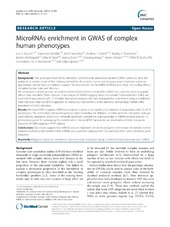| dc.contributor.author | Goulart, Luiz Fernando De Souza | en_US |
| dc.contributor.author | Bettella, Franscesco | en_US |
| dc.contributor.author | Sønderby, Ida Elken | en_US |
| dc.contributor.author | Schork, AJ | en_US |
| dc.contributor.author | Thompson, Kurt Wesley | en_US |
| dc.contributor.author | Mattingsdal, Morten | en_US |
| dc.contributor.author | Steen, Vidar Martin | en_US |
| dc.contributor.author | Zuber, Verena | en_US |
| dc.contributor.author | Wang, Yunpeng | en_US |
| dc.contributor.author | Dale, Anders | en_US |
| dc.contributor.author | Andreassen, Ole Andreas | en_US |
| dc.contributor.author | Djurovic, Srdjan | en_US |
| dc.date.accessioned | 2015-06-25T12:42:37Z | |
| dc.date.available | 2015-06-25T12:42:37Z | |
| dc.date.issued | 2015-04-16 | |
| dc.identifier.issn | 1471-2164 | |
| dc.identifier.uri | https://hdl.handle.net/1956/10070 | |
| dc.description.abstract | Background: The genotype information carried by Genome-wide association studies (GWAS) seems to have the potential to explain more of the ‘missing heritability’ of complex human phenotypes, given improved statistical approaches. Several lines of evidence support the involvement of microRNA (miRNA) and other non-coding RNA in complex human traits and diseases. We employed a novel, genetic annotation-informed enrichment method for GWAS that captures more polygenic effects than standard GWAS analysis, to investigate if miRNA-tagging Single Nucleotide Polymorphisms (SNPs) are enriched of associations with 15 complex human phenotypes. We then leveraged the enrichment using a conditional False Discovery Rate (condFDR) approach to assess any improvement in the detection of individual miRNA SNPs associated with the disorders. Results: We found SNPs tagging miRNA transcription regions to be significantly enriched of associations with 10 of 15 phenotypes. The enrichment remained significant after controlling for affiliation to other genomic categories, and was confirmed by replication. Albeit only nominally significant, enrichment was found also in miRNA binding sites for 10 phenotypes out of 15. Leveraging the enrichment in the condFDR framework, we observed a 2-4-fold increase in discovery of SNPs tagging miRNA regions. Conclusions: Our results suggest that miRNAs play an important role in the polygenic architecture of complex human disorders and traits, and therefore that miRNAs are a genomic category that can and should be used to improve gene discovery. | en_US |
| dc.language.iso | eng | eng |
| dc.publisher | BioMed Central | eng |
| dc.rights | Copyright 2015 Goulart et al.; licensee BioMed Central | eng |
| dc.rights.uri | http://creativecommons.org/licenses/by/4.0 | eng |
| dc.subject | Polygenic | eng |
| dc.subject | Genomic enrichment | eng |
| dc.subject | Genome-wide association study | eng |
| dc.subject | Conditional false discovery rate | eng |
| dc.subject | miRNA | eng |
| dc.title | MicroRNAs enrichment in GWAS of complex human phenotypes | en_US |
| dc.type | Peer reviewed | |
| dc.type | Journal article | |
| dc.date.updated | 2015-06-25T12:38:25Z | |
| dc.description.version | publishedVersion | en_US |
| dc.source.articlenumber | 304 | |
| dc.identifier.doi | https://doi.org/10.1186/s12864-015-1513-5 | |
| dc.identifier.cristin | 1238005 | |
| dc.source.journal | BMC Genomics | |
| dc.source.40 | 16 | |

